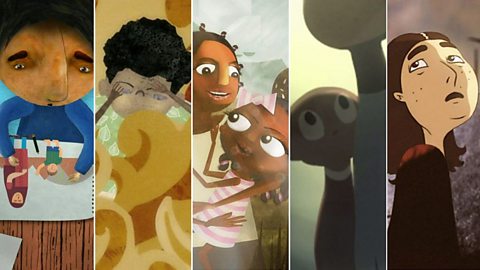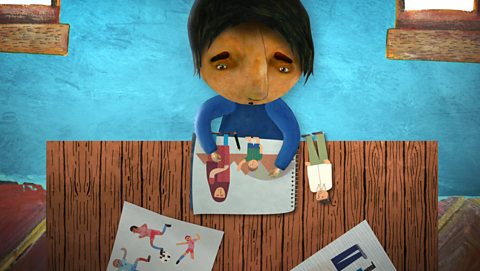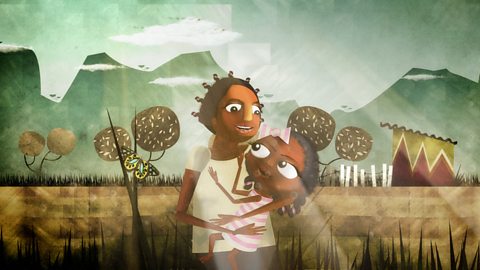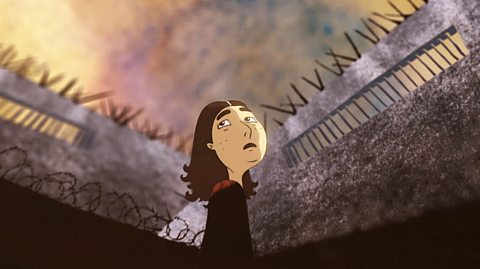
Five animated stories giving a unique insight into the lives of young people who have sought refuge in the UK, told by the children themselves.
Individually or together, these short films can be used to develop an understanding of why some people become refugees, and therefore help raise questions and challenge perceptions about motivation and persecution.
They can be used to start a discussion around what it might be like for refugee children adapting to life in the UK, identity, and the effects of alienation and displacement they may experience.
How to use the KS3 PSHE: Seeking Refuge films
The films could also generate discussion for different writing genres, providing an example of narrative and describing personal experiences, and for helping pupils develop empathy for refugees by giving them a direct insight into individual's thoughts, feelings and experiences.
These films can be used as part of a planned programme of learning within Relationships and Health Education, PSHE or RE. Due to the nature of their content they are most suitable for use with pupils in KS3, but could also be considered (with teacher discretion) for Year 6.

Safe teaching and learning
The films contain content which some children might find upsetting, so it is essential to establish a safe teaching and learning environment before class viewing. There may be pupils in school who are themselves refugees and have had, or know people who have had, traumatic experiences of war or leaving their own countries. There may also be pupils who are not themselves refugees, but have experienced upheavals and separation from home or family, for example, those looked after by the local authority.
Please read the accompanying guidance (below) and view each film before exploring it with students, considering its suitability for your cohort with care, especially if using it with a younger age group.
Ali's journey from Afghanistan. video
Ali - a ten-year-old boy - fled to the UK with his grandmother during the war in Afghanistan. Ali describes the pain of separation from his family as well as his experiences adjusting to life in the UK.

Hamid's journey from Eritrea. video
Following the journey of ten-year-old Hamid from Eritrea, who was forced to leave his home country. Hamid candidly describes the struggles of settling into life in a new and unfamiliar country.

Juliane's journey from Zimbabwe. video
The story of Juliane from Zimbabwe, who spent years living away from her mother in an orphanage before reuniting and escaping the country together.

Navid's journey from Iran. video
With his father's life in danger, Navid - aged just five - was forced to flee his home in Iran with his mother and make the long journey to the UK.

Rachel's journey from a country in Eurasia. video
Following the journey of 17-year-old Rachel, who escaped religious persecution in her country and settled into a new life in the UK before being deported.

Teacher Notes for PSHE: Seeking Refuge lesson
Safe teaching and learning
Ensure a safe environment for using these films by doing the following for each lesson in which they are used:
Create or revisit ground rules
Remind pupils of any existing ground rules you might already use, or agree ground rules with them before the lesson. Examples could include:
- The films are the stories of real people - be sensitive in your comments
- Discuss the situations in the films, not personal experiences (unless these are willingly volunteered)
- Make judgements and comments based on what people say and do, not on who they are
- Discuss the situations and experiences shown in the films, not popular opinion, speculation, conjecture or unsupported assumptions about refugees and immigrants
- Everyone has the right to pass
Encourage and respond to questions safely
An anonymous question box or sticky notes can help pupils ask questions privately and anonymously and enable you to prepare responses to questions you may not immediately be able to answer, or identify any potential safeguarding issues or disclosures.
Be sensitive to individual pupils who may themselves be refugees or have experienced war and conflict, either directly or indirectly. You may want to discuss the films with these pupils ahead of the session, or give them the choice not to view if they prefer. Sensitivity is important even if you are not aware of any personal experiences in the class - working on the basis that there is at least one person who may be vulnerable ensures safe delivery for all. No-one should be placed under any pressure to discuss their own circumstances or experiences - any personal information or experience should be done so voluntarily and willingly.
Always work within your schoolÔÇÖs safeguarding and confidentiality policies and procedures
This is especially important if a student makes a disclosure. If you are unsure of the procedures, seek advice from your Designated Safeguarding Lead.
Signpost students to sources of additional information or support if they need it, including named adults within school. Some external sources of support are given below.
Using the Seeking Refuge films
The films can be used flexibly to suit your teaching needs, depending on your cohort, scheme of work, subject/topic area, learning objectives, etc. You can choose how to view them with your students, whether one or more in a lesson, over a series of lessons, or all at the same time. You should allow time for related activities, questioning and discussion, and you may also want to build in some quiet reflection time at the end of the lesson before pupils leave the classroom.
Discussion and activities
The following notes are general suggestions for ways to structure discussion around the films as a whole, or develop further opportunities for understanding. Next to each film (above) are additional questions or considerations specific to that film's content.
Introductory KS3 PSHE activities
- Before showing the films, build in time to find out the background to the situation in the countries featured so that pupils have a context to the story (eg. the status of Kurdish people in Iran). Pupils could do this research themselves, or the class could prepare questions to ask about the countries which they could research in groups. Locate the countries on a map. and discuss anything the class might already know about that country and its situation. Highlight any recent news stories relating to the country, and why this story is relevant to us in the UK (eg. the British withdrawal from Afghanistan in 2014 and again in 2021).
- Ask pupils why people become refugees, or what they know already about refugees, and collate their responses, for example, on a graffiti wall. Keep the wall to refer back to during future discussion, pupils could also add responses to it in different colours as their learning and understanding about refugees develops through viewing the films. Once all lessons have taken place you could use the responses to compare 'what we knew then' to 'what we know now' - this can also feed in to assessment of learning objectives. Note: be alert to any negative or baseless assumptions and judgements (including racism), and challenge these where necessary.
- Explain that a key reason for people seeking asylum is because they are persecuted (denied basic rights) based on their gender, sexuality, race, religion, nationality or because they belong to a particular social group or have particular political opinions that conflict with the politics of government. Ask if they can think of an example of this happening (eg. Jewish persecution in Nazi Germany).
- Other reasons for people fleeing from their countries are due to war, or ethnic or political violence. Can they think of any recent examples of these (eg. the Russian invasion of Ukraine)?
- Emphasise to pupils that refugees are defined in and protected by international law, and that seeking asylum is not a crime.
- Discuss the and the reasons why most countries in the world are signed up to it. Highlight some of the articles (eg. 28: right to education; 38: war and conflict; 9: separation from parents; 30: minority and indigenous groups) and also Article 22, which requires governments to give aid and assistance to refugee children. While watching the films, pupils could consider whether each child's rights are being met, or compare rights within the children's home countries versus the UK.
- Ask pupils to imagine that when they go home that night, a parent or other adult tells them that they have to leave their home in the morning and go to an entirely different country. Ask them to write a list of how they might feel, or questions that they might have if this happened.
Continuum line:
- Create an imaginary line across the classroom and label the ends Strongly agree and Strongly disagree. Read out some statements such as the examples below, and ask pupils to place themselves on the line depending on the strength of their response to these. Pick out pupils to explain reasons for their positioning. After viewing the films, do the continuum activity again with the same statements to see if pupils place themselves differently or give different reasons for their placings.
- An alternative to this activity is Corners: place a different statement in each corner of the room (or on walls or tables as space allows). Ask pupils to move to the statement with which they most agree, or remain in the middle of the room if they are undecided. Ask students in different corners to share their reasons for their choice, then give everyone the opportunity to change positions or join a corner if they are undecided.
- Examples of statements:
- Anyone should be allowed entry to the UK if they are escaping from war, famine or persecution related to their race, religion, gender, sexuality or nationality
- No refugees should be allowed to enter the UK
- Only certain refugees should be allowed to enter the UK
- All refugee children should be allowed to live in the UK
- Refugee children should not be allowed into the UK alone
- No refugee children should stay in the UK without a parent
- Only refugees arriving from certain countries should be allowed to stay in the UK
- If I had to leave the UK because of war or persecution, I should be allowed to enter and stay in another country
- Anyone can become a refugee
Activities to follow viewing of the films
One theme of the films is the importance of friendship, especially for Hamid, Ali and Navid. Using their experiences, explore issues around friendship and how friends can contribute towards giving someone a sense of belonging and identity. Some questions to promote discussion could include:
- How do friendships bring about change for Hamid/Ali/Navid (or all three)?
- How do their friendships help them?
- What can friendships bring to someone's life?
- How do your friendships support you/how do you support your friends?
- Ask pupils to think of different ways in which they could include or befriend someone who has recently come to this country. Are there ways to do this despite a language barrier?
Another theme of the films is hope. Explore with pupils how the children in the films stay hopeful and positive, despite extreme adversity - what enables them to do that (eg. friendships, creativity, community)?
Ask pupils to choose one of the children featured and describe their life in the future: what do they think they will be doing? How might their lives be different if they had not left their own countries? How do you think their lives might benefit the UK and their home countries in future?
After viewing all the films, ask pupils what children like those featured would need to help them feel welcomed and not isolated. Based on the experiences they have seen, ask pupils to put together ideas for a Refugee welcome pack of things they could say or do, as individuals, a class or as a school community, to help a refugee arriving in their school.
KS3 PSHE Curriculum
Relationships, sex and health education
Links to: The benefits of healthy relationships to mental wellbeing; how families contribute to human happiness; the characteristics of positive and healthy friendships; that happiness is being linked to being connected to others.
PSHE education (non-statutory)
Links to:
Core theme 1: Health and wellbeing/self-concept
Core theme 2: Relationships/Relationship values/Positive relationships
Core theme 3: Living in the Wider World/Communities
RE
Links will depend on the RE syllabus that a local authority, faith school or academy follows.

If your students need support
You should always tell someone about the things youÔÇÖre worried about. You can tell a friend, parent, guardian, teacher, or another trusted adult. If you're struggling with your mental health, going to your GP can be a good place to start to find help. Your GP can let you know what support is available to you, suggest different types of treatment and offer regular check-ups to see how youÔÇÖre doing.
If youÔÇÖre in need of in-the-moment support you can contact , where you can speak to a counsellor. Their lines are open 24 hours a day, 7 days a week.
There are more links to helpful organisations on 91╚╚▒Č Action Line.

Where next?
The Colour of my Skin - Real stories of racism in the UK
This powerful collection of short animated films uses real testimony from young people of colour to explore personal experiences of racism, bullying and isolation. These are real stories of racism in the UK.

Bitesize Secondary
Use these Bitesize resources to set homework, independent study tasks or to consolidate learning for your students.

Newsround
The latest news stories from Newsround to share in the classroom.


External learning-related websites:
- teaching resources can support or link to the Seeking Refuge films.
- - Teaching resources for using with children and young people, including links to films, school speakers and classroom materials.
- - Resources focussed around the Holocaust and the impact on peopleÔÇÖs lives of more recent genocides, such as in Sudan.
- - An education and activity pack created for young people of all ages, based around the ÔÇśjourneyÔÇÖ undertaken by Little Amal, the 12-foot puppet of a 10-year-old Syrian refugee child at the heart of The Walk.